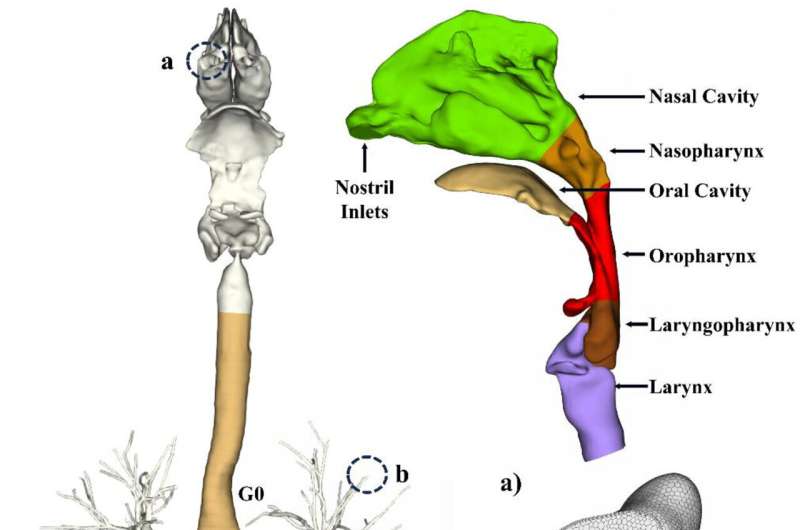This article has been reviewed according to Science X's editorial process and policies. Editors have highlighted the following attributes while ensuring the content's credibility:
fact-checked
trusted source
proofread
Every breath you take: Following the journey of inhaled plastic particle pollution

With recent studies having established the presence of nano and microplastic particles in the respiratory systems of both human and bird populations, a new study has modeled what happens when people breathe in different kinds of plastic particles and where they end up.
Led by Senior Lecturer of Mechanical Engineering Dr. Suvash Saha, the University of Technology Sydney (UTS) research team has used computational fluid-particle dynamics (CFPD) to study the transfer and deposition of nano and microplastic particles of different sizes and shapes depending on the rate of breathing.
The results of the modeling, published in the journal Environmental Advances, have pinpointed hotspots in the human respiratory system where plastic particles can accumulate, from the nasal cavity and larynx and into the lungs. The paper is titled, "Transport and deposition of microplastics and nanoplastics in the human respiratory tract."
Dr. Saha said evidence was mounting on the significant impact of nano and microplastics on respiratory health and the UTS study would provide essential insights for the development of targeted strategies to mitigate potential risks and ensure effective health interventions.
"Experimental evidence has strongly suggested that these plastic particles amplify human susceptibility to a spectrum of lung disorders, including chronic obstructive pulmonary disease, fibrosis, dyspnea (shortness of breath), asthma, and the formation of what are called frosted glass nodules," Dr. Saha said.
"Plastic particle air pollution is now pervasive and inhalation ranks as the second most likely pathway for human exposure.
"The primary types are intentionally manufactured, including a wide array of cosmetics and personal care products such as toothpaste.
"The secondary ones are fragments derived from the degradation of larger plastic products, such as water bottles, food containers and clothes.
"Extensive investigations have identified synthetic textiles as a principal source of indoor airborne plastic particles, while the outdoor environment presents a multitude of sources encompassing contaminated aerosols from the ocean to particles originating from wastewater treatment."

Dr. Saha said the UTS team's modeling found that breathing rate along with particle size and shape determined where in the respiratory system plastic particles would be deposited.
"Faster breathing rates led to heightened deposition in the upper respiratory tract, particularly for larger microplastics, whereas slower breathing facilitated deeper penetration and deposition of smaller nanoplastic particles," he said.
"Particle shape was another factor, with non-spherical microplastic particles showing a propensity for deeper lung penetration compared to spherical microplastics and nanoplastics, potentially leading to different health outcomes.
"These findings highlight the imperative consideration of breathing rates and particle sizes in health risk assessments associated with respiratory exposure to nano and microplastic particles."
More information: Xinlei Huang et al, Transport and deposition of microplastics and nanoplastics in the human respiratory tract, Environmental Advances (2024). DOI: 10.1016/j.envadv.2024.100525
Provided by University of Technology, Sydney





















